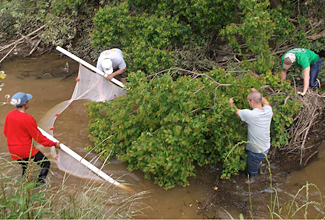Published December 16, 2013
Students and faculty from the University of Louisiana at Monroe’s Toxicology Department
recently presented environmental data at the Louisiana Department of Environmental
Quality’s (LDEQ) Non-Point Source (NPS) Pollution Annual Project Review Meeting in
Baton Rouge.
ULM toxicology instructor John Herrock and toxicology
students conduct fish surveys for the Mississippi River
Basin Initiative grant project.
The meeting brought together investigators involved in the LDEQ NPS grant program
to present their findings and exchange ideas and information to improve water quality
throughout the state of Louisiana.
Dr. Kevin Baer, head of ULM toxicology said, “This is an important meeting to dialogue
with state and regional environmental officials regarding the regulation and improvement
of our watersheds throughout Louisiana. We discuss current problems and emerging
issues that affect our water quality and also share solutions that have resulted from
individual projects. The ultimate goal is to improve water quality through integrated
watershed approaches that involve all of the stakeholders; academic researchers, governmental
agencies, community/environmental groups, and the residents of Louisiana.”
Baer served as principle investigator for ULM’s presentation, and John Herrock, instructor
of toxicology, was the co-principle investigator. C. Mandi Simmons, a pharmacy Ph.D.
graduate student from Keithville, was also part of the research team.
Baer presented the results for grants titled “Watershed Monitoring in the Ouachita
River Basin - Joe's Bayou: Phase II;” “Mississippi River Basin Initiative (MRBI)
Watershed Water Quality Monitoring Project in Bayou Lafourche Tributaries;” and “Identification
and Reduction of NPS Pollutants to Bayou DeSiard in the Ouachita River Basin.”
Simmons presented findings on the “MRBI Watershed Water Quality Monitoring Project
in Turkey Creek,” and Herrock presented the biological survey results supporting both
the Bayou Lafourche and Turkey Creek projects.
Officials and project managers from LDEQ, EPA (region six), statewide watershed coordinators,
Resource Conservation and Development, and researchers from other academic and government
institutions observed and gave presentations as part of the meeting.
The ULM toxicology program curriculum consists of a four-year program designed to
include a solid foundation in basic sciences, a broad background in toxicology with
several specialized courses and sufficient non-science courses to provide students
with a well-rounded education.
The toxicology coursework spans the field of clinical, environmental, and industrial
toxicology.
Within the field of Industrial Toxicology, special emphasis is given to Industrial
Hygiene theory and practice.
Photo of fish survey courtesy


